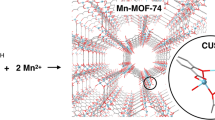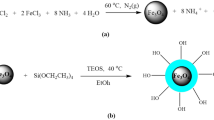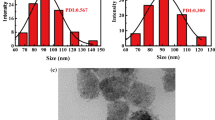Abstract
Metal-organic frameworks (MOFs) have shown a great potential as a novel contrast agent in magnetic resonance imaging (MRI) due to their unique properties including versatile structures, composition, and surface chemistry. Fe-MIL-88B-NH2 (MILs) was synthesized using Fe+3 ions and 2-aminoterephthalic acids (NH2-BDC) in the presence of acetic acid and Pluronic F127 under a hydrothermal process. Three MILs in different sizes were synthesized by using variant CH3COOH/Fe+3 molar ratios and denoted as MIL-S, MIL-M, and MIL-L having average sizes of 60, 350, and 730 nm, respectively. The effect of aspect ratio and particle size of MILs was investigated on proton relaxivity and contrast enhancement in aqueous, in vitro, and in vivo MR images. MRI study indicated that by increasing the MILs size, the incremental transverse relaxivity was achieved from 13.53 to 50.80 for r2 and from 38.75 to 60.25 for r2*, while the difference between r2 and r2* was decreased obviously. The r2/r1 ratios were found to be 5.80, 42.27, and 127.00 for MIL-S, MIL-M, and MIL-L, respectively. All MILs demonstrated T2-weighted MR imaging performance. Furthermore, no susceptibility artifacts were observed on T2-weighted images of MILs. By decreasing the size of MILs, r2/r1 ratio was reduced sharply and T1 contrast was also observed for MIL-S. MIL-S was used for in vitro and in vivo study due to its capability in simultaneous T1 and T2 contrast enhancements. MTT and hemolysis assays showed no significant cytotoxicity and hemolysis for MIL-S against normal human breast cell line (MCF-10A) and red blood cells, respectively, at concentrations of Fe+3 up to 300 μg/mL (p < 0.05). T1-weighted images acquired from in vitro study interestingly showed that the signal intensity of MIL-S is more than Dotarem. The in vivo experiment revealed that the signal intensity of mice liver decreased sharply after injection resulting in increase of negative contrast enhancement. The negative contrast enhancement decreased gradually by the time under T2-weighted imaging mode confirming application of MIL-S as a T2 contrast agent in biomedical applications (up to 12 h post-injection). Although a decrease of the size resulted in bright contrast in aqueous solution for MIL-S, it did not show proper efficiency for in vivo positive contrast enhancement. The advantages, including simple preparation and accessibility, acceptable potency and selectivity, blood compatibility, and suitable cytocompatibility as well as enough circulation time, make MIL-S as a dual MRI contrast agent to differentiate between low-contrast tissues for in vivo experiments.












Similar content being viewed by others
References
Aeineh N, Salehi F, Akrami M, Nemati F, Alipour M, Ghorbani M, Nikfar B, Salehian F, Riyahi Alam N, Sadat Ebrahimi SE, Foroumadi A (2018) Glutathione conjugated polyethylenimine on the surface of Fe3O4 magnetic nanoparticles as a theranostic agent for targeted and controlled curcumin delivery. J Biomater Sci Polym Ed 29:1109–1125. https://doi.org/10.1080/09205063.2018.1427013
Ahrentorp F, Astalan A, Blomgren J, Jonasson C, Wetterskog E, Svedlindh P, Lak A, Ludwig F, Van IJzendoorn LJ, Westphal F, Grüttner C (2015) Effective particle magnetic moment of multi-core particles. J Magn Magn Mater 380:221–226. https://doi.org/10.1016/j.jmmm.2014.09.070
Aime S, Caravan P (2009) Biodistribution of gadolinium-based contrast agents, including gadolinium deposition. JMRI 30:1259–1267. https://doi.org/10.1002/jmri.21969
Al Faraj A, Shaik AS, Afzal S, Al Sayed B, Halwani R (2014) MR imaging and targeting of a specific alveolar macrophage subpopulation in LPS-induced COPD animal model using antibody-conjugated magnetic nanoparticles. Int J Nanomedicine 9:1491–1503. https://doi.org/10.2147/IJN.S59394
Azizian G, Riyahi-Alam N, Haghgoo S, Moghimi HR, Zohdiaghdam R, Rafiei B, Gorji E (2012) Synthesis route and three different core-shell impacts on magnetic characterization of gadolinium oxide-based nanoparticles as new contrast agents for molecular magnetic resonance imaging. Nanoscale Res Lett 7:549–558. https://doi.org/10.1186/1556-276X-7-549
Bannas P, Motosugi U, Ichikawa S, Hernando D, Reeder SB (2014) Primer on magnetic resonance imaging of the liver. Clin Liver Dis 4:120–123. https://doi.org/10.1002/cld.440
Benito J, Fenero M, Sorribas S, Zornoza B, Msayib KJ, McKeown NB, Téllez C, Coronas J, Gascón I (2015) Fabrication of ultrathin films containing the metal organic framework Fe-MIL-88B-NH2 by the Langmuir–Blodgett technique. Colloids Surf A Physicochem Eng Asp 470:161–170
Casula MF, Conca E, Bakaimi I, Sathya A, Materia ME, Casu A, Falqui A, Sogne E, Pellegrino T, Kanaras AG (2016) Manganese doped-iron oxide nanoparticle clusters and their potential as agents for magnetic resonance imaging and hyperthermia. Phys Chem Chem Phys 18:16848–16855. https://doi.org/10.1039/C6CP02094A
Della Rocca J, Liu D, Lin W (2011) Nanoscale metal–organic frameworks for biomedical imaging and drug delivery. Acc Chem Res 44:957–968. https://doi.org/10.1021/ar200028a
Dybtsev DN, Chun H, Kim K (2004) Rigid and flexible: a highly porous metal–organic framework with unusual guest-dependent dynamic behavior. Angew Chem 116:5143–5146. https://doi.org/10.1002/ange.200460712
Férey G, Mellot-Draznieks C, Serre C, Millange F (2005) Crystallized frameworks with giant pores: are there limits to the possible? Acc Chem Res 38:217–225. https://doi.org/10.1021/ar040163i
Gao Z, Nakanishi Y, Noda S, Omachi H, Shinohara H, Kimura H, Nagasaki Y (2017) Development of Gd3N@ C80 encapsulated redox nanoparticles for high-performance magnetic resonance imaging. J Biomater Sci Polym Ed 28:1036–1050. https://doi.org/10.1080/09205063.2017.1288774
Gascon J, Aktay U, Hernandez-Alonso MD, van Klink GP, Kapteijn F (2009) Amino-based metal-organic frameworks as stable, highly active basic catalysts. J Catal 261:75–87. https://doi.org/10.1016/j.jcat.2008.11.010
Ghorbani M, Bigdeli B, Jalili-baleh L, Baharifar H, Akrami M, Dehghani S, Goliaei B, Amani A, Lotfabadi A, Rashedi H, Haririan I (2018) Curcumin-lipoic acid conjugate as a promising anticancer agent on the surface of gold-iron oxide nanocomposites: a pH-sensitive targeted drug delivery system for brain cancer theranostics. Eur J Pharm Sci 114:175–188. https://doi.org/10.1016/j.ejps.2017.12.008
Hatakeyama W, Sanchez TJ, Rowe MD, Serkova NJ, Liberatore MW, Boyes SG (2011) Synthesis of gadolinium nanoscale metal− organic framework with hydrotropes: manipulation of particle size and magnetic resonance imaging capability. ACS Appl Mater Interfaces 3:1502–1510. https://doi.org/10.1021/am200075q
Herédia V, Altun E, Ramalho M, Semelka RC (2007) Magnetic resonance imaging of the liver: a review. Expert opinion on medical diagnostics 1:213–223. https://doi.org/10.1517/17530059.1.2.213
Heydarnezhadi S, Alam NR, Haghgoo S, Ghanaati H, Khoobi M, Gorji E, Rafiei B, Nikfari B, Amirrashedi M (2016) Glycosylated gadolinium as potential metabolic contrast agent vs Gd-DTPA for metabolism of tumor tissue in magnetic resonance imaging. Appl Magn Reson 47:375–385. https://doi.org/10.1007/s00723-015-0756-2
Horcajada P, Chalati T, Serre C, Gillet B, Sebrie C, Baati T, Eubank JF, Heurtaux D, Clayette P, Kreuz C, Chang JS (2010) Porous metal-organic-framework nanoscale carriers as a potential platform for drug delivery and imaging. Nat Mater 9:172–178. https://doi.org/10.1038/nmat2608
Horcajada P, Gref R, Baati T, Allan PK, Maurin G, Couvreur P, Ferey G, Morris RE, Serre C (2011) Metal–organic frameworks in biomedicine. Chem Rev 112:1232–1268. https://doi.org/10.1021/cr200256v
Huang J, Bu L, Xie J, Chen K, Cheng Z, Li X, Chen X (2010) Effects of nanoparticle size on cellular uptake and liver MRI with polyvinylpyrrolidone-coated iron oxide nanoparticles. ACS Nano 4:7151–7160. https://doi.org/10.1021/nn101643u
Jo DH, Kim JH, Lee TG, Kim JH (2015) Size, surface charge, and shape determine therapeutic effects of nanoparticles on brain and retinal diseases. Nanomedicine 11:1603–1611. https://doi.org/10.1016/j.nano.2015.04.015
Jun YW, Huh YM, Choi JS, Lee JH, Song HT, Kim S, Kim S, Yoon S, Kim KS, Shin JS, Suh JS (2005) Nanoscale size effect of magnetic nanocrystals and their utilization for cancer diagnosis via magnetic resonance imaging. J Am Chem Soc 127:5732–5733. https://doi.org/10.1021/ja0422155
Jun YW, Lee JH, Cheon J (2008) Chemical design of nanoparticle probes for high-performance magnetic resonance imaging. Angew Chem Int Ed 47:5122–5135. https://doi.org/10.1002/anie.200701674
Kim BH, Lee N, Kim H, An K, Park YI, Choi Y, Shin K, Lee Y, Kwon SG, Na HB, Park JG (2011) Large-scale synthesis of uniform and extremely small-sized Iron oxide nanoparticles for high-resolution T1 magnetic resonance imaging contrast agents. J Am Chem Soc 133:12624–12631. https://doi.org/10.1021/ja203340u
Lee N, Yoo D, Ling D, Cho MH, Hyeon T, Cheon J (2015) Iron oxide based nanoparticles for multimodal imaging and magnetoresponsive therapy. Chem Rev 115:10637–10689. https://doi.org/10.1021/acs.chemrev.5b00112
Li H, Eddaoudi M, O’Keeffe M, Yaghi OM (1999) Design and synthesis of an exceptionally stable and highly porous metal-organic framework. Nature 402:276–279. https://doi.org/10.1038/46248
Luo N, Tian X, Yang C, Xiao J, Hu W, Chen D, Li L (2013) Ligand-free gadolinium oxide for in vivo T1-weighted magnetic resonance imaging. Phys Chem Chem Phys 15:12235–12240. https://doi.org/10.1038/46248
Ma M, Noei H, Mienert B, Niesel J, Bill E, Muhler M, Fischer RA, Wang Y, Schatzschneider U, Metzler-Nolte N (2013) Iron metal–organic frameworks MIL-88B and NH2-MIL-88B for the loading and delivery of the gasotransmitter carbon monoxide. Chem Eur J 19(21):6785–6790. https://doi.org/10.1002/chem.201201743
Na HB, Hyeon T (2009) Nanostructured T1 MRI contrast agents. J Mater Chem 19:6267–6273. https://doi.org/10.1039/B902685A
Na HB, Song IC, Hyeon T (2009) Inorganic nanoparticles for MRI contrast agents. Adv Mater 21:2133–2148. https://doi.org/10.1002/adma.200802366
Nayab S, Trouillet V, Gliemann H, Hurrle S, Weidler PG, Tariq SR, Goldmann AS, Barner-Kowollik C, Yameen B (2017) Chemically reprogrammable metal organic frameworks (MOFs) based on Diels–Alder chemistry. Chem Commun 53:11461–11464. https://doi.org/10.1039/C7CC06150A
Nikfar B, Alam NR, Haghgoo S, Ghanaati H, Ghanbari H, Khoobi M, Rafiei B, Gorji E, Heydarnezhadi S (2016) Correlation of signal intensity and ICP/OES-related concentration of gadolinium-based nanomagnetic particles in molecular MRI: in vitro study. Appl Magn Reson 47:77–86. https://doi.org/10.1007/s0072
Pham M-H, Vuong G-T, Vu A-T, Do T-O (2011) Novel route to size-controlled Fe–MIL-88B–NH2 metal–organic framework nanocrystals. Langmuir 27:15261–15267. https://doi.org/10.1021/la203570h
Qin J, Laurent S, Jo YS, Roch A, Mikhaylova M, Bhujwalla ZM, Muller RN, Muhammed M (2007) A high-performance magnetic resonance imaging T2 contrast agent. Adv Mater 19:1874–1878. https://doi.org/10.1002/adma.200602326
Rieter WJ, Taylor KM, An H, Lin W, Lin W (2006) Nanoscale metal− organic frameworks as potential multimodal contrast enhancing agents. J Am Chem Soc 128:9024–9025. https://doi.org/10.1021/ja0627444
Rouquerol J, Avnir D, Fairbridge CW, Everett DH, Haynes JM, Pernicone N, Ramsay JD, Sing KS, Unger KK (1994) Recommendations for the characterization of porous solids (technical report). Pure Appl Chem 66:1739–1758. https://doi.org/10.1351/pac199466081739
Rowe MD, Thamm DH, Kraft SL, Boyes SG (2009) Polymer-modified gadolinium metal-organic framework nanoparticles used as multifunctional nanomedicines for the targeted imaging and treatment of cancer. Biomacromolecules 10:983–993. https://doi.org/10.1021/bm900043e
Sava Gallis DF, Rohwer LE, Rodriguez MA, Barnhart-Dailey MC, Butler KS, Luk TS, Timlin JA, Chapman KW (2017) Multifunctional, tunable metal–organic framework materials platform for bioimaging applications. ACS Appl Mater Interfaces 9:22268–22277. https://doi.org/10.1021/acsami.7b05859
Sene S, Marcos-Almaraz MT, Menguy N, Scola J, Volatron J, Rouland R, Grenèche JM, Miraux S, Menet C, Guillou N, Gazeau F (2017) Maghemite-nanoMIL-100 (Fe) bimodal nanovector as a platform for image-guided therapy. Chem 3:303–322. https://doi.org/10.1016/j.chempr.2017.06.007
Shen Z, Chen T, Ma X, Ren W, Zhou Z, Zhu G, Zhang A, Liu Y, Song J, Li Z, Ruan H (2017) Multifunctional theranostic nanoparticles based on exceedingly small magnetic iron oxide nanoparticles for T1-weighted magnetic resonance imaging and chemotherapy. ACS Nano 11:10992–11004. https://doi.org/10.1021/acsnano.7b04924
Shin T-H, Choi Y, Kim S, Cheon J (2015) Recent advances in magnetic nanoparticle-based multi-modal imaging. Chem Soc Rev 44:4501–4516. https://doi.org/10.1039/C4CS00345D
Sitharaman B, Tran LA, Pham QP, Bolskar RD, Muthupillai R, Flamm SD, Mikos AG, Wilson LJ (2007) Gadofullerenes as nanoscale magnetic labels for cellular MRI. Contrast Media Mol Imaging 2:139–146. https://doi.org/10.1002/cmmi.140
Sjögren CE, Johansson C, Nævestad A, Sontum PC, Briley-Sæbø K, Fahlvik AK (1997) Crystal size and properties of superparamagnetic iron oxide (SPIO) particles. Magn Reson Imaging 15:55–67. https://doi.org/10.1016/S0730-725X(96)00335-9
Taboada E, Rodríguez E, Roig A, Oró J, Roch A, Muller RN (2007) Relaxometric and magnetic characterization of ultrasmall iron oxide nanoparticles with high magnetization. Evaluation as potential T1 magnetic resonance imaging contrast agents for molecular imaging. Langmuir 23:4583–4588. https://doi.org/10.1021/la063415s
Wu S-C, Chen Y-J, Lin Y-J, Wu T-H, Wang Y-M (2013) Development of a mucin4-targeting SPIO contrast agent for effective detection of pancreatic tumor cells in vitro and in vivo. J Med Chem 56:9100–9109. https://doi.org/10.1021/jm401060z
Xiao K, Li Y, Luo J, Lee JS, Xiao W, Gonik AM, Agarwal RG, Lam KS (2011) The effect of surface charge on in vivo biodistribution of PEG-oligocholic acid based micellar nanoparticles. Biomaterials 32:3435–3446. https://doi.org/10.1016/j.biomaterials.2011.01.021
Xie J, Chen K, Huang J, Lee S, Wang J, Gao J, Li X, Chen X (2010) PET/NIRF/MRI triple functional iron oxide nanoparticles. Biomaterials 31:3016–3022. https://doi.org/10.1016/j.biomaterials.2010.01.010
Yan Y, Zhang J, Ren L, Tang C (2016) Metal-containing and related polymers for biomedical applications. Chem Soc Rev 45:5232–5263. https://doi.org/10.1039/C6CS00026F
Zeng L, Ren W, Zheng J, Cui P, Wu A (2012) Ultrasmall water-soluble metal-iron oxide nanoparticles as T 1-weighted contrast agents for magnetic resonance imaging. Phys Chem Chem Phys 14:2631–2636. https://doi.org/10.1039/C2CP23196D
Zhao S, Yin H, Du L, He L, Zhao K, Chang L, Yin G, Zhao H, Liu S, Tang Z (2014) Carbonized nanoscale metal–organic frameworks as high performance electrocatalyst for oxygen reduction reaction. ACS Nano 8:12660–12668. https://doi.org/10.1021/nn505582e
Zhou EL, Qin C, Wang XL, Shao KZ, Su ZM (2016) Assembly of two novel 3D organic–inorganic hybrids based on Keggin-type polyoxometalates: syntheses, crystal structures and properties. CrystEngComm 18:6370–6377. https://doi.org/10.1039/C6CE00021E
Zhu Q-L, Xu Q (2014) Metal–organic framework composites. Chem Soc Rev 43:5468–5512. https://doi.org/10.1039/C3CS60472A
Funding
This study was supported by Tehran University of Medical Sciences for facilitation and financial support by grant number 94-04-30-30992.
Author information
Authors and Affiliations
Corresponding authors
Ethics declarations
The in vivo study was performed in accordance with the European Community guidelines and approved by local ethical committee, Tehran University of Medical Sciences (TUMS), Tehran, Iran (Approval number: IR.TUMS.REC.1395.132).
Conflict of interest
The authors declare that they have no conflict of interest.
Rights and permissions
About this article
Cite this article
Dehghani, S., Alam, N.R., Shahriarian, S. et al. The effect of size and aspect ratio of Fe-MIL-88B-NH2 metal-organic frameworks on their relaxivity and contrast enhancement properties in MRI: in vitro and in vivo studies. J Nanopart Res 20, 278 (2018). https://doi.org/10.1007/s11051-018-4376-2
Received:
Accepted:
Published:
DOI: https://doi.org/10.1007/s11051-018-4376-2




